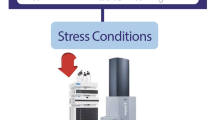Abstract
Purpose. To find out if the physical instability of a lyophilized dosage form is related to molecular mobility below the glass transition temperature. Further, to explore if the stability data generated at temperatures below the glass transition temperature can be used to predict the stability of a lyophilized solid under recommended storage conditions.
Methods. The temperature dependence of relaxation time constant, τ, was obtained for sucrose and trehalose formulations of the monoclonal antibody (5 mg protein/vial) from enthalpy relaxation studies using differential scanning calorimetry. The non-exponentiality parameter, β, in the relaxation behavior was also obtained using dielectric relaxation spectroscopy.
Results. For both sucrose and trehalose formulations, the variation in τ with temperature could be fitted Vogel-Tammann-Fulcher (VTF) equation. The two formulations exhibited difference sensitivities to temperature. Sucrose formulation was more fragile and exhibited a stronger non-Arrhenius behavior compared to trehalose formulation below glass transition. Both formulations exhibited <2% aggregation at tτ values <10, where t is the time of storage.
Conclusions. Since the relaxation times for sucrose and trehalose formulations at 5°C are on the order of 108 and 106 hrs, it is likely that both formulations would undergo very little (<2%) aggregation in a practical time scale under refrigerated conditions.
Similar content being viewed by others
REFERENCES
L. C. E. Struik. Physical Aging in Amorphous Polymers and Other Materials. Elsevier Scientific Publishing Company, New York, 1978.
B. C. Hancock, S. L. Shamblin, and G. Zografi. Pharm. Res. 12:799–806 (1995).
C. A. Angell. Science 267:1924–1935 (1995).
R. Bohmer, K. L. Ngai, C. A. Angell, and D. J. Plazek. J. Chem. Phys. 99:4201–4209 (1993).
C. A. Angell and D. L. Smith. J. Phys. Chem. 86:3845–3852 (1982).
C. A. Angell, L. Monnerie, and L. M. Torell. Mat. Res. Soc. Symp. Proc. 215:3–9 (1991).
C. A. Angell, R. D. Bressel, J. L. Green, H. Kanno, M. Oguni, and E. J. Sare. J. Food. Eng. 22:115–142 (1994).
S. P. Duddu and K. Weller. J. Pharm. Sci. 85:345–347 (1996).
S. P. Duddu and P. R. Dal Monte. Pharm. Res. 14:591–595 (1997).
G. Williams and D. C. Watts. Trans. Faraday Soc. 66:80–85 (1970).
S. Havriliak and S. Negami. J. Polymer. Sci: Part C 14:99–117 (1966).
P. K. Dixon. Phys. Rev. B 42:8179–8186.
Author information
Authors and Affiliations
Rights and permissions
About this article
Cite this article
Duddu, S.P., Zhang, G. & Dal Monte, P.R. The Relationship Between Protein Aggregation and Molecular Mobility Below the Glass Transition Temperature of Lyophilized Formulations Containing a Monoclonal Antibody. Pharm Res 14, 596–600 (1997). https://doi.org/10.1023/A:1012196826905
Issue Date:
DOI: https://doi.org/10.1023/A:1012196826905




